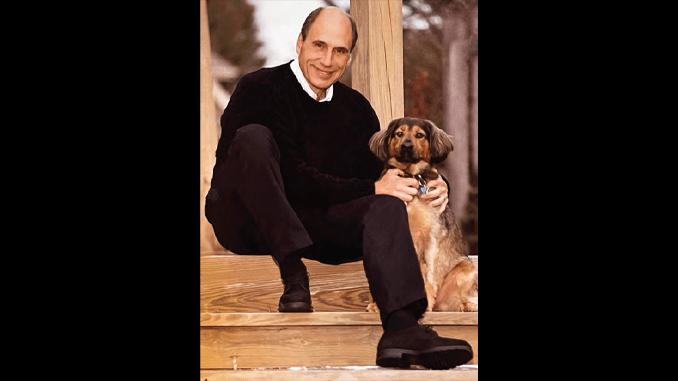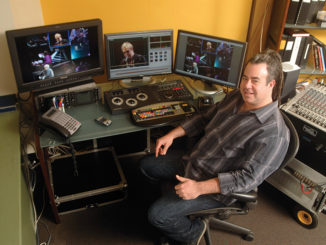
MARCH 24, 1949–JAN. 5, 2023
Picture editor Mike Hill, ACE, who died on Jan. 5 at the age of 73, spent his career in the company of a most eclectic cast of characters.
Over the course of a career that lasted more than three decades, the Academy Award-winning editor helped give shape and style to movies about a mermaid, a group of senior citizens who have tapped into a fountain of youth, a family of firefighters, a gaggle of newspapermen and –women, several heroic astronauts fighting to survive in outer space, and a Grinch.
Partnering with career-long colleague Dan Hanley, ACE, Hill co-edited an unusually eclectic group of pictures for director Ron Howard that included “Splash” (1984), “Cocoon” (1985), “Backdraft” (1991), “The Paper” (1994), “Apollo 13” (1995) — for which the team won Oscars — and “How the Grinch Stole Christmas” (2000). Hanley and Hill also received Oscar nominations for “A Beautiful Mind” (2002), “Cinderella Man” (2005), and “Frost/Nixon” (2008).
“Mike would tell anyone who asked that he was the luckiest person in the film industry,” said Hill’s widow, LeAnne Baker. “He got to work every day with people he trusted, respected and considered family. He counted the 22 films he made with partner Dan Hanley and director Ron Howard as one of his life’s greatest achievements.”
Speaking with CineMontage, Howard repaid the compliment. “I always felt Mike could have been a director if he wanted to,” Howard said. “He was very thoughtful about story and character. He had great taste in movies, and a broad appreciation for films of all types. . . . He was a pleasure to be in the trenches with because he was always going to speak the truth, but he was also a complete team player.”
Born to John and Maxine Hill in Omaha, Nebraska, in 1949, Hill attended the University of Nebraska at Omaha, from which he received a degree in criminal justice in 1972. While in school, Hill had the first taste of what would become his life’s work when he was hired as an assistant film editor for a local television station. His responsibilities included splicing commercial breaks into classic movies that were being readied for broadcast, including Elia Kazan’s “On the Waterfront” (1954).
When he first moved to California, however, Hill initially found employment in the field he had studied: He worked as a guard at the California Institution for Men, a prison in Chino. “He realized prison work was not going to be his future so he drove to Los Angeles and applied for work at all the unions,” Baker said. “Editorial offered him a job as an apprentice at Paramount.”
That’s where he first encountered Hanley, who was six years his junior. “We worked together in shipping and then he got a job as an apprentice on the Hal Ashby film ‘Bound for Glory,’” Hanley said. “Our paths crossed again when he came back to Paramount.”
Hill, who also served as an apprentice on Kazan’s “The Last Tycoon” (1976), invited Hanley into the cutting room. “A couple times he would let me come upstairs and show me how to sync dailies on ‘The Last Tycoon,’” said Hanley, adding that the two developed a rapport outside of work, too.
“We were pretty good friends,” Hanley said. “We played basketball together. Garry Marshall had a court on the [Paramount] lot. . . . Mike was a big movie buff. He would just revel in really interesting actors. I remember, while we were in shipping, he would take me to a USC film festival where they showed old-time movies. . . . We saw these Brando films, films that I probably never would have seen, like ‘Reflections in a Golden Eye.’”
In time, both editors had come to work with veteran picture editor Robert James Kern, whose credits dated back to the 1950s. Kern, who had edited the first few made-for-TV movies of Ron Howard, was slated to work with Hanley and Hill on Howard’s feature film debut, “Night Shift” (1982).
When Kern suffered a stroke, however, Hanley and Hill were left to work on the picture — and the studio became nervous about the relatively inexperienced editors.
“Ron went to bat for us,” Hanley said. “He came up with an angle, saying, ‘Hey, why don’t we bring on this old MGM editor, Bob Kern, as a supervisor? He won’t be able to cut much, but he can keep an eye on these two guys.’ And the studio said, ‘OK.’”
Howard said that due to the editors’ efforts, “Night Shift” was released some six months ahead of schedule.
“Because the film came so quickly, in a miraculous three-and-a-half weeks from the time we wrapped, we had virtually what our final cut was going to be,” Howard said. “The studio loved it, and it tested really well.”
Thus began one of the longest-lasting partnerships in postproduction.
“I had to fight for them as a team on ‘Splash,’” said Howard, referring to his first film after “Night Shift.” “But I really loved their chemistry.”
Hanley and Hill proved their bona fides on their next film with Howard, “Cocoon”: The editors winnowed a three-hour cut of the film to releasable length.
“It was solid — no one was in a panic — but we knew it couldn’t live at three hours,” Howard said. “[Producers] Richard and Lili [Zanuck] and David Brown all went away for their Christmas break, . . . and we dug in over Christmas and took 55 minutes out of the movie. There was a tremendous amount of experimentation, but a lot of creativity: combining scenes, finding ways to meld two scenes into one in a really effective way.”
Howard knew he had found his editorial team for years to come.
“I just knew Dan and Mike had something special together — individually both incredibly talented guys who did work on their own from time to time,” Howard said. “From then on, I felt our working relationship was something to build upon.”
Hanley and Hill would each cut their own scenes, but because they were both so attuned to the film’s underlying style and theme, no one would be able to tell who cut what.
“Something clicked,” Hanley said. “A couple people have said: ‘How did that even work that you put three people together and they just clicked?’ Well, it just seemed like the director and the film dictates the sensibility, so our cuts really shouldn’t look that different between scenes.”
The pair went by instinct in deciding who cut what on a given movie.
“The first scene would come in,” Hanley said. “We’d look at each other and say, ‘Do you want it?’ ‘Well, what’s coming in next?’ ‘You mind taking this one? I’ll take the next one.’ . . . He got to cut the first round of that fight scene, so I would cut the next round. It fell into a natural rhythm in dividing up the scenes.”
Among the highlights of their collaboration, Hanley said, were the racing scenes in Howard’s Formula One movie “Rush” (2013), for which they received a BAFTA Award; and the long dialogue scenes in “Frost/Nixon,” starring Michael Sheen as David Frost and Frank Langella as Richard Nixon.
Howard praises Hill’s interventions in a fight scene in “Cinderella Man.”
“Mike went back to work on it and just suddenly it had the intensity, it had the emotion that I was looking for,” Howard said. “He said he started experimenting, and he was using fragments — frames — from seven different camera angles on a single punch. It was imperceptible. Once I understood what he was doing, I could follow it, but it was so organic by appearances and yet so artfully achieved.” “Mike was a humble, generous guy,” Hanley said.” “His ego never got in the way. His ego was about getting the best cut. If there was any competition, it was just about making sure your scenes looked as good as the other guy’s, or you didn’t let your partner down.”
Added Howard: “If they really were changing anything, or really making any big bold revisions, they’d always share it between themselves. They had a lot of respect for each other.”
After working together as usual on Howard’s “In the Heart of the Sea” (2015), Hill received a diagnosis of COP (cryptogenic organizing pneumonia) and, at that time, he decided it was time to retire. Hanley co-edited Howard’s next picture, “Inferno” (2016), with Tom Elkins, ACE, before retiring himself.
“I wouldn’t have had it any other way,” Hanley said of a lifetime of collaborating with Hill. “After Mike passed, I had never felt like this before. You don’t know what you’ve lost until it’s gone.”
In addition to his wife, Hill, who relocated to his native Omaha in 1988, is survived by his daughter, Jesica; son-in-law, Brandon; and sisters, Nancy Walter and Vicki Henderson. His brother, Ken Hill, preceded him in death.
- Peter Tonguette






